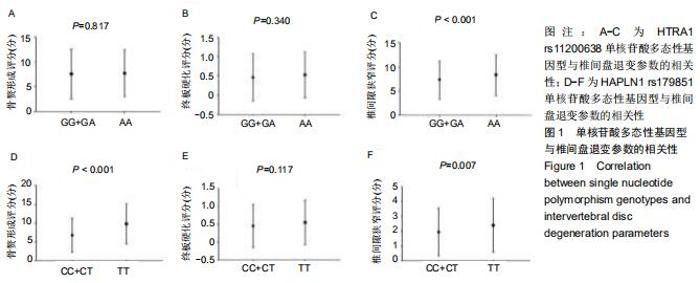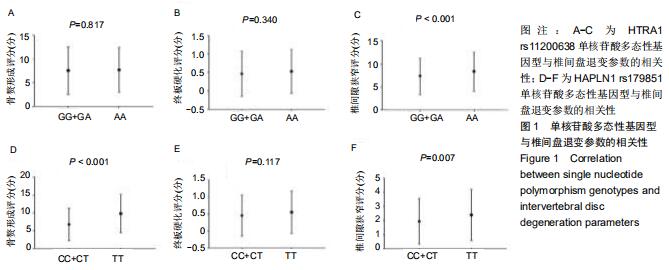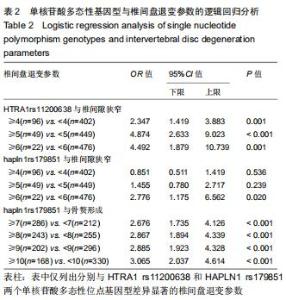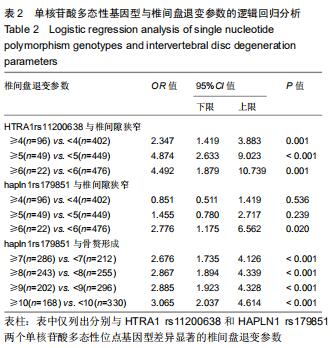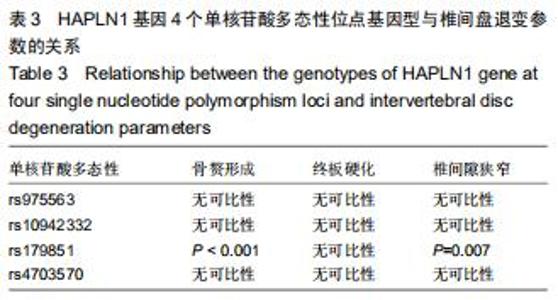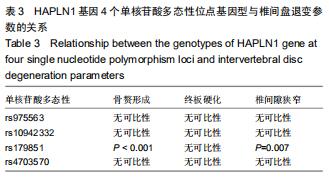|
[1] 劳杨骏,王继涛,徐涛涛,等.椎间盘退变前驱因素终板退变研究现状[J].中华中医药杂志,2017,32(9):236-239.
[2] PYE SR, REID DM ,LUNT M.许俊杰(译).腰椎间盘退变:与骨刺形成、终板硬化和椎间隙狭窄的关系[J].脊柱外科杂志,2006,4(5):317-318.
[3] HU XJ, CHEN LH, BATTIÉ MC, et al. Methodology and cohort profile for the Hangzhou Lumbar Spine Study: a study focusing on back health in a Chinese population.J Zhejiang Univ Sci B. 2018;19(7):547-558.
[4] 李大鹏,吴燕,岳佳伟,等.髓核组织高温相关丝氨酸蛋白酶A1表达水平与椎间盘退变程度的相关性[J].中国医学科学院学报,2017,39(6):737-742.
[5] ALTOBELLI E, LATELLA G, MORRONI M, et al. Low HtrA1 expression in patients with long‑standing ulcerative colitis and colorectal cancer. Oncol Rep.2017;38(1):418-426.
[6] MORT JS, GENG Y, FISHER WD, et al. Aggrecan heterogeneity in articular cartilage from patients with osteoarthritis.BMC Musculoskelet Disord.2016;17(1):89.
[7] FENG Y, EGAN B, WANG J. Genetic Factors in Intervertebral Disc Degeneration.Genes Dis.2016;3(3):178-185.
[8] AKHATIB B, ONNERFJORD P, GAWRI R, et al. Chondroadherin Fragmentation Mediated by the Protease HTRA1 Distinguishes Human Intervertebral Disc Degeneration from Normal Aging.J Biol Chem.2013;288(26):19280-19287.
[9] 梁庆元,宋洁富,秦集斌,等.椎间盘退变的相关遗传易感基因研究进展[J].中华骨科杂志,2016,36(18):1208.
[10] LONG KR, NEWLAND B, FLORIO M, et al. Extracellular Matrix Components HAPLN1, Lumican, and Collagen I Cause Hyaluronic Acid-Dependent Folding of the Developing Human Neocortex.Neuron. 2018;99(4):702-719.e6.
[11] WANG W, YU Y, HAO J, et al. Genome-wide DNA methylation profiling of articular cartilage reveals significant epigenetic alterations in Kashin-Beck disease and osteoarthritis.Osteoarthritis Cartilage. 2017; 25(12):2127-2133.
[12] ZHANG M, LU Q, MILLER AH, et al. Dynamic epigenetic mechanisms regulate age-dependent SOX9 expression in mouse articular cartilage. Int J Biochem Cell B.2016;72:125-134.
[13] YU W, GLÜER CC, FUERST T, et al. Influence of degenerative joint disease on spinal bone mineral measurements in postmenopausal women.Calcif Tissue Int.1995;57(3):169-174.
[14] OH CH, YOON SH. Whole Spine Disc Degeneration Survey according to the Ages and Sex Using Pfirrmann Disc Degeneration Grades. Korean J Spine.2017;14(4):148-154.
[15] ALVAREZ-GARCIA O, MATSUZAKI T, OLMER M, et al. Age‐related reduction in the expression of FOXO transcription factors and correlations with intervertebral disc degeneration.J Orthop Res. 2017; 35(12):2682-2690.
[16] RITCHIE GRS, ROUMELIOTIS TI, STEINBERG J, et al. Integrated molecular phenotyping identifies genes and pathways disrupted in osteoarthritis.BioRxiv.2016: 038067.doi: http://dx.doi.org/10.1101/038067.
[17] DEWAN A, LIU M, HARTMAN S, et al. HTRA1 promoter polymorphism in wet age-related macular degeneration.Am J Ophthalmol. 2006; 143(2): 376-376.
[18] MENG FH, SHAO XL, SONG Y, et al. Correlation between the Expression of High Temperature Requirement Serine Protease A1 in Nucleus Pulposus Tissue and the Degree of Intervertebral Disc Degeneration.Zhongguo Yi Xue Ke Xue Yuan Xue Bao. 2017;39(6): 737-742.
[19] 岳佳伟,李大鹏,吴燕,等.椎间盘退变患者髓核组织中HtrA1的表达及其与MMPs的关系[J].山东医药,2017,57(22):83-85.
[20] URANO T, NARUSAWA K, KOBAYASHI S, et al. Association of HTRA1 promoter polymorphism with spinal disc degeneration in Japanese women. J Bone Miner Metab.2010;28(2):220-226.
[21] FURTWÄNGLER T, CHAN SC, BAHRENBERG G, et al. Assessment of the Matrix Degenerative Effects of MMP-3, ADAMTS-4, and HTRA1, Injected Into a Bovine Intervertebral Disc Organ Culture Model. Spine (Phila Pa 1976).2013;38(22):E1377-E1387.
[22] MEBARKI S, DÉSERT R, SULPICE L, et al. De novo HAPLN1 expression hallmarks Wnt-induced stem cell and fibrogenic networks leading to aggressive human hepatocellular carcinomas. Oncotarget. 2016;7(26):39026.
[23] LIU J, PARK ES, CURRY TE JR, et al. Periovulatory Expression of Hyaluronan and Proteoglycan Link Protein 1 (Hapln1) in the Rat Ovary: Hormonal Regulation and Potential Function.Mol Endocrinol. 2010; 24(6):1203-1217.
[24] YAMAKAWA A, HOJO H, CHUNG U, et al. Identification of a chondrocyte-specific Indian Hedgehog enhancer and SOX9-mediated mechanisms of the enhancer activation.Osteoarthr Cartilage. 2018; 26:S12-S13.
[25] YUCESOY B, CHARLES LE, BAKER B, et al. Occupational and genetic risk factors for osteoarthritis: a review.Work.2015;50(2):261-273.
|
